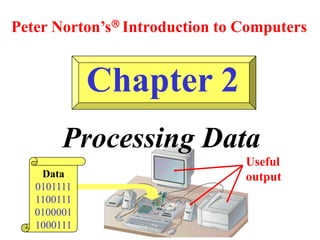Report
Share

Recommended
More Related Content
Similar to Lec2.ppt
Similar to Lec2.ppt (20)
An Introduction To Python - Understanding Computers

An Introduction To Python - Understanding Computers
BCS 100: Introduction to Computer Science Lesson 3

BCS 100: Introduction to Computer Science Lesson 3
The 8086 Micro Processor Architecture By Dr. RidhaJemal

The 8086 Micro Processor Architecture By Dr. RidhaJemal
Recently uploaded
Differences between analog and digital communicationanalog-vs-digital-communication (concept of analog and digital).pptx

analog-vs-digital-communication (concept of analog and digital).pptxKarpagam Institute of Teechnology
Recently uploaded (20)
Instruct Nirmaana 24-Smart and Lean Construction Through Technology.pdf

Instruct Nirmaana 24-Smart and Lean Construction Through Technology.pdf
NEWLETTER FRANCE HELICES/ SDS SURFACE DRIVES - MAY 2024

NEWLETTER FRANCE HELICES/ SDS SURFACE DRIVES - MAY 2024
UNIT-2 image enhancement.pdf Image Processing Unit 2 AKTU

UNIT-2 image enhancement.pdf Image Processing Unit 2 AKTU
Seismic Hazard Assessment Software in Python by Prof. Dr. Costas Sachpazis

Seismic Hazard Assessment Software in Python by Prof. Dr. Costas Sachpazis
Involute of a circle,Square, pentagon,HexagonInvolute_Engineering Drawing.pdf

Involute of a circle,Square, pentagon,HexagonInvolute_Engineering Drawing.pdf
analog-vs-digital-communication (concept of analog and digital).pptx

analog-vs-digital-communication (concept of analog and digital).pptx
Developing a smart system for infant incubators using the internet of things ...

Developing a smart system for infant incubators using the internet of things ...
Fuzzy logic method-based stress detector with blood pressure and body tempera...

Fuzzy logic method-based stress detector with blood pressure and body tempera...
Maximizing Incident Investigation Efficacy in Oil & Gas: Techniques and Tools

Maximizing Incident Investigation Efficacy in Oil & Gas: Techniques and Tools
Filters for Electromagnetic Compatibility Applications

Filters for Electromagnetic Compatibility Applications
Independent Solar-Powered Electric Vehicle Charging Station

Independent Solar-Powered Electric Vehicle Charging Station
Lec2.ppt
- 1. Chapter 2 Processing Data Peter Norton’s Introduction to Computers Data 0101111 1100111 0100001 1000111 Useful output
- 2. Learning Objectives: • Identify the main difference between data and information. • List two reasons why computers use the binary number system. • List the two main parts of the CPU and explain how they work together to process data. • Name three differences between RAM and ROM. • List three hardware features that affect processing speed. • Name the two best-known families of CPUs and list their differences.
- 3. Data - raw facts Information - meaningful data (useful output)
- 4. Number Systems: Decimal Numbers - Base 10 Notation Binary Numbers - Base 2 Notation
- 5. Bits and Bytes: •Bit = binary digit - Smallest unit of data •Byte = 8 bits
- 6. Computers represent data with electrical switches. = 1 = 0 On-off circuits are simple and are not prone to errors. 0 1 0 0 1 0 0 0 One byte is made up of 8 bits. (binary 01001000 = decimal 72) (ASCII 01001000 = the letter “H”)
- 7. Computer parts communicate using binary numbers. The greater the number of bits moved at one time, the faster the processing speed.
- 8. Text Codes: EBCDIC “EB-si-dic” - (Extended Binary Coded Decimal Interchange Code) ASCII “As-key” - (American Standard Code for Information Interchange) Unicode - (Unicode Worldwide Character Standard)
- 9. CPU (Central Processing Unit) - the brain of the computer Two parts: • CU (Control Unit) • ALU (Arithmetic/Logic Unit)
- 10. Control Unit - Controls the flow of data into and from the Central Processing Unit.
- 11. Arithmetic/Logic Unit - Performs Arithmetic functions and Logical operations.
- 12. The CU and ALU are in the CPU.
- 13. Types of Memory: ROM - Read Only Memory (contains the basic input output system or BIOS) RAM - Random Access Memory (user programs and data go here)
- 14. The ROM is nonvolatile because it will not lose its contents when powered down. RAM plugs into sockets on the motherboard.
- 15. Adding RAM often increases system performance.
- 16. The CPU can read RAM much faster than it can the hard disk.
- 18. CPU Models: • 8086 1978 • 8088 1979 • 80286 1982 • 80386 1985 • 80486 1989 • Pentium 1993 • Penium Pro 1995 • Pentium II 1997
- 19. The Pentium II has 7.5 million transistors, more than double the number included on the original Pentium chip. It can operate from 233 MHz to 400 MHz and beyond. About MHz: the faster the clock, the faster the processing speed. (1 MHz = 1 million clock cycles per second)
- 20. Learning Objectives: Chapter 2 Review • Identify the main difference between data and information. • List two reasons why computers use the binary number system. • List the two main parts of the CPU and explain how they work together to process data. • Name three differences between RAM and ROM. • List three hardware features that affect processing speed. • Name the two best-known families of CPUs and list their differences.